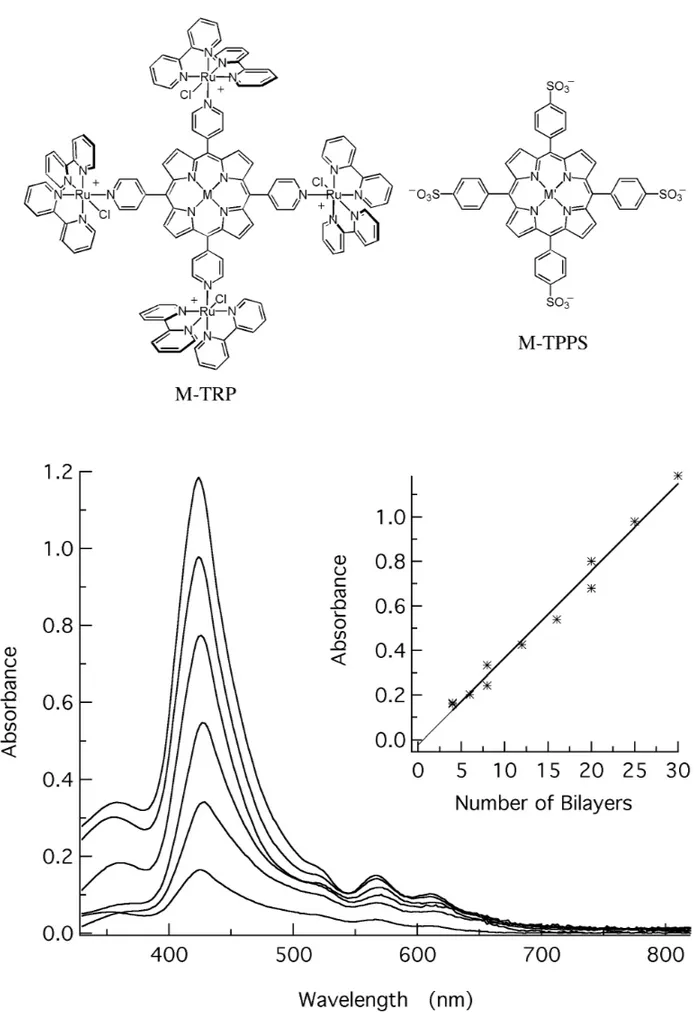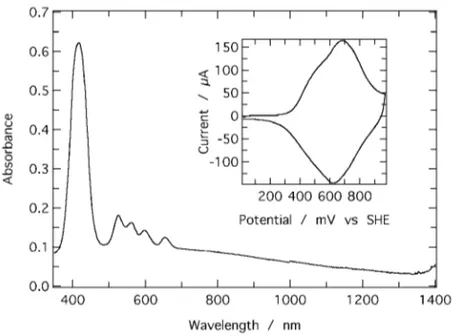KOITI ARAKI, SIMONE DE SOUZA LIMA and HERBERT WINNISCHOFER
Instituto de Química - USP, Cx. Postal 26.077 – 05599-970 - São Paulo, SP, Brazil
Manuscript received on September 8, 1999; accepted for publication on September 15, 1999; presented byJosé M. Riveros
ABSTRACT
A relevant series of symmetric supramolecular porphyrins has been obtained by attaching four [RuII(bipy)2Cl] groups to the pyridyl substituents of meso-tetra(4-pyridyl)porphyrin and its metallated derivatives. These compounds display a rich electrochemistry and versatile catalytic, electrocatalytic and photochemical prop-erties, associated with the ruthenium-bipyridine and the porphyrin complexes. These properties can be transferred to the electrodes by attaching thin molecular films of the compounds, by dip-coating, electro-static assembly or electropolymerization. In this way, the interesting properties of those supermolecules and supramolecular assemblies can be used to prepare molecular devices and sensors.
Key words:Polynuclear porphyrins, thin molecular films, chemical sensors.
INTRODUCTION
Supramolecular chemistry (Lehn 1988) involves the formation of spatially organized assemblies of two or more molecular entities through covalent bonds, electrostatic forces or weak van der Waals interac-tions. There is a huge amount of known and newly prepared chemicals that can be combined generat-ing an infinite number of supramolecular assem-blies and materials, exhibiting interesting catalytic, electrocatalytic, photoelectrochemical and molecu-lar recognition properties.
The porphyrins and ruthenium polypyridines (Kalyanasundaram 1992; Bediouiet al. 1996) are two classes of compounds exhibiting most of the above mentioned molecular properties. Consequen-tly, the build-up of polymetallic supermolecules based on porphyrins and ruthenium bipyridine com-plexes has been pursued with great interest. A rel-evant series of symmetric polynuclear species has
Correspondence to:
Koiti Araki, koiaraki@iq.usp.br
been obtained by attaching four [RuII(bipy)2Cl]
groups to the pyridyl substituents of meso-tetra(4-pyridyl)porphyrin and its metallated derivatives (Toma & Araki 2000). These compounds display a rich electrochemistry and versatile catalytic and photochemical properties, associated with the ruthenium-bipyridine complexes and the porphyrin ring. Another interesting property is their ability to form homogeneous and adherent films, which make possible the transfer of the properties of the supramolecular porphyrins to an electrode surface. This is of paramount importance for the generation of new devices, sensors and interfaces. In this short review we report our studies on thin molecular films of supramolecular porphyrins and give a preview of the advances with a couple of new electropolymer-izable porphyrin series.
THIN MOLECULAR FILMS
THIN MOLECULAR FILMS OF SUPRAMOLECULAR PORPHYRINS 28
properties are defined mainly by the molecular and supramolecular properties of their components. So, it is possible to devise new materials and transfer their chemical, photochemical and photophysical properties to solid substrates.
There are many methods to obtain thin lar films. Two well established ones are the molecu-lar beam epitaxy and thermoevaporation methods. However, these are vacuum techniques generally limited to volatile and thermally stable compounds. Milder methods can be used to obtain thin films with a high degree of molecular organization, for example by self-assembly of thiols on gold surfaces, by Lang-muir/Blodget (LB) method and electrostatic assem-bly. The last two methods can be used to obtained multilayer molecular films with variable composi-tion, in contrast with the first one that almost exclu-sively generates monolayers or submonolayers.
The electrostatic assembly method was restric-ted to materials in which at least one of the species was a macromolecular poly-ion (Cooper et al.
1995). However, the electrostatic interaction be-tween two oppositely charged species can generate very insoluble materials. So, by using an “in-situ” ion-exchange method involving tetraruthenated porphyrins (TRP) and tetra-(4-sulphonatephenyl)-porphyrins (TPPS) we were able to obtain homoge-neous bilayered porphyrin films (Arakiet al. 1996). This is a method that has a close resemblance with the LB method, because the resulting materials are layered and it is possible to combine many different molecular species at will. Furthermore, the thick-ness can be controlled at molecular level, as can be inferred by the linear increase of the absorbance (Fig. 1) and thickness as a function of the number of bilayers.
FILM PROPERTIES
The supramolecular porphyrin films have electro-chemical, electrocatalytic, photoelectrochemical and also semiconducting properties. However, the dip-coated materials were relatively soluble in aque-ous solution, even in the presence of an excess of
lithium trifluoromethanesulfonate (counter-anion), used as electrolyte. To address this problem we de-vised a method for electrostatic assembling cationic and anionic porphyrins to obtain bilayered materi-als, exhibiting good stability and low solubility in aqueous solution. The properties of both types of films will be presented in the following paragraphs. The electrochemistry of M-TRP films is de-fined by the properties of the peripheral ruthenium complexes and the porphyrin ring. In aqueous solu-tion, the potential is limited to about -1.0 to +1.0 V range, such that only the Ru3+/2+and the M3+/2+ redox reactions of the metal ion (Fe, Co and Mn) coordinated to the porphyrin ring can be accessed. For example, dip-coated NiTRP films (Arakiet al.
1995) exhibit only the reversible pair of waves cor-responding to Ru3+/2+couple, at 0.92 V. When this modified electrode is used, the typical reversible response of a [Fe(CN)6]4− sample solution is not
observed at 0.41 V. Instead, only a sharp and in-tense oxidation peak is found at the beginning of the Ru(II/III) wave. This is an evidence that the film is acting as an insulating barrier, except at poten-tials in which some Ru(III) complexes are formed. This is evidence that the mechanism of conduction is by electron-hopping and the film is homogeneous enough to completely avoid the ferrocyanide ion to reach the electrode surface. In fact, the system Ni-TRP film/ferrocyanide has a diode-like behavior, al-lowing the transport of electrons from the solution to the electrode, but not in the opposite direction.
The TRP modified glassy carbon elec-trodes are photoelectrochemically active. For ex-ample, an electrode dip-coated with ZnTRP gener-ates a photocurrent (Araki & Toma 1994) when irra-diated with visible light in an electrochemical cell, in the presence of dissolved molecular oxygen. Elec-trodes modified with electrostatically assembled Zn-TRP/TPPS films exhibit the same behavior and the photoaction spectrum is similar to the spectrum of the film (Arakiet al. 1996), confirming its photo-electrochemical activity.
THIN MOLECULAR FILMS OF SUPRAMOLECULAR PORPHYRINS 30
of chemical sensors and devices. On the other hand, there is an increasing pressure to have more sensitive and specific sensors to identify and quantify a myr-iad of substrates; especially those involved in key biological functions and of environmental interest. M-TRP modified electrodes were shown to be use-ful in the detection of nitrite, sulfite, ascorbic acid, dopamine and NADH, by flow injection analysis (Toma & Araki 2000). For all those substrates a sen-sibility in theµM level or less was reached. In fact, the electrocatalytic activity of the CoTRP/ZnTPPS sensor was used to perform the analysis of sulfite content in wines (Azevedoet al.1999). The results were very similar to those obtained by using stan-dard methods, but the FIA method has the advantage of being faster, easier to use and more reproducible.
NEW SYSTEMS
The methods of dip-coating and electrostatic assem-bly are very convenient, but it is not possible to de-posit the porphyrin films on a restricted area on the substrate surface. This is a very important feature for the design and preparation of a multisensor device in which each microelectrode of an array is covered with a thin film of a specific material. In this case, even the Langmuir-Blodget and thermoevaporation methods are not suitable, being preferable to use the electropolymerization technique. This is a general and convenient method for the deposition of stable and insoluble films only on the polarized electrode surfaces.
So, two new supramolecular porphyrin series are being studied and the preliminary results are shown below. The first one is based on the elec-tropolymerization properties of 5-chloro-1,10-phenanthroline, 5ClPhen, ligand (Fussa-Rydelet al.
1989). The corresponding supramolecular por-phyrin species, ETRP, was obtained by sub-stituting the [Ru(bipy)2Cl]+complexes of TRP by
[Ru(5ClPhen)2Cl]+ groups. Consequently, the
ETRP molecule has eight carbon atoms able to form C-C bonds per porphyrin supermolecule, enabling the formation of a polymeric network. Quite
homo-geneous and electrochemically active films were ob-tained as can be seen in Figure 2, where the structure and the cyclic voltammogram of the free-base proto-type is shown. The waves at 1.04;−0.64;−0.98 and
−1.13 V can be ascribed to the Ru3+/Ru2+, P0/P−,
P−/P2−and
[Ru(5ClPhen)2Cl]/[Ru(5ClPhen)(5ClPhen)−Cl]
redox processes.
By coordinating [Fe(CN)5]3−groups to
meso-3-pyridylporphyrin, it was obtained the prototype species of the second series of electropolymerizable supermolecule, TPCFP. In this case, it is possible to generate quite insoluble Prussian blue like materials (Tomaet al.1993) simply by adding transition metal ions to its aqueous solution. These are amorphous solids, but the films obtained by controlled deposi-tion probably have a high degree of molecular orga-nization. The films prepared by electrochemical de-position on nickel electrodes are very homogeneous and probably contain channels sided by porphyrin rings and Prussian blue like structures. This kind of structure is adequate for the occurrence of molecular recognition and electrocatalysis, and consequently for the preparation of chemical microsensors. In Figure 3 are shown the electronic spectrum and the cyclic voltammogram of a TPCFP film obtained on nickel electrode, confirming its electrochemical ac-tivity. The Soret and Q bands were found at 417, 526, 562, 599 and 655 nm, confirming the pres-ence of porphyrin in the material. Furthermore, the spectrum of the TPCFP in aqueous solution presents a shoulder at 435 nm, assigned to the FeII(dπ)→
py(pπ∗) charge transfer transition, which confirms the coordination of the pentacyanoferrate groups to the pyridine moieties of the porphyrin.
FINAL REMARKS
Fig. 2 – Cyclic voltammogram of a polymeric film of ETRP obtained by reductive electropolymerization of a dip-coated film of the monomer on a platinum electrode, in acetonitrile, TEAClO40.1 M. Inset: Structure of ETRP Molecule.
THIN MOLECULAR FILMS OF SUPRAMOLECULAR PORPHYRINS 32
porphyrins are adequate to prepare molecular films on specific electrodes in an individually addressable electrode array, making possible the preparation of sensors that may respond simultaneously to multiple substrates.
ACKNOWLEDGEMENTS
We gratefully acknowledge the Brazilian agencies FAPESP and CNPq for the financial support.
REFERENCES
Araki K & Toma & HE1994. Luminescence,
Spec-troelectrochemistry and Photoelectrochemical Prop-erties of a Tetraruthenated Zinc Porphyrin. J Pho-tochem Photobiol A- Chem 83:245-250.
Araki K, Angnes L & Toma HE1995. Rectifying
Properties and Photoconductivity of Tetraruthenated Nickel Porphyrin Films.Adv Materials 7:554-559.
Araki K, Wagner MJ & Wrighton MS1996.
Layer-by-layer growth of electrostatically assembled mul-tilayer porphyrin films.Langmuir 12:5393-5398.
Azevedo CMN, Araki K, Toma HE & Angnes L1999.
Determination of sulfur dioxide in wines by gas-diffusion flow injection analysis utilizing modified electrodes with electrostatically assembled films of tetraruthenated porphyrin. Anal Chim Acta 387:
175-180.
Bedioui F, Devynck J & BiedCharreton C 1996.
Electropolymerized manganese porphyrin films as catalytic electrode materials for biomimetic oxida-tions with molecular oxygen.J Mol Cat A-Chemical
113:3-11.
Cooper TM, Campbell AL & Crane RL1995.
For-mation of Polypeptide-Dye Multilayers By an Elec-trostatic Self-Assembly Technique. Langmuir 11:
2713-2718.
Fussa-Rydel O, Zhang H-T, Hupp JT & Leidner CR
1989. Electrochemical assembly of metallo- poly-meric films via reaction of coordinated 5- chloro-phenanthroline.Inorg Chem 28:1533-1537.
Kalyanasundaram K 1992. Photochemistry of
Polypyridine and Porphyrin Complexes. New York: Academic Press.
Lehn J-M1988. Supramolecular Chemistry (Nobel
Lec-ture).Angew Chem Int Ed Engl 27:89.
Toma HE & Araki K 2000. Supramolecular
assem-blies of ruthenium complexes and porphyrins.Coord Chem Rev 196:307-329.
Toma HE, Matsumoto FM & Cipriano C1993.

